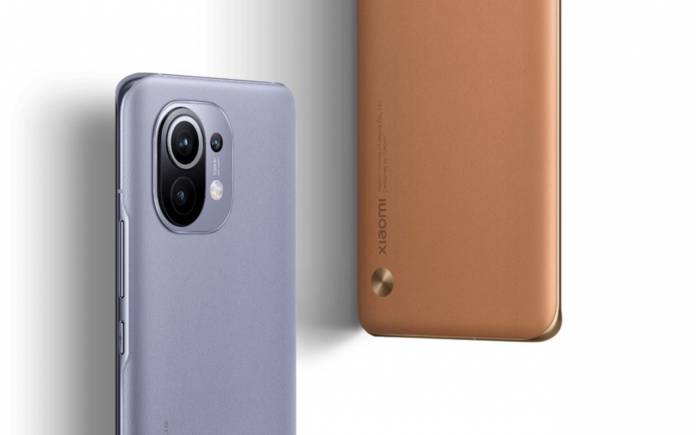
From the Xiaomi blog post:
As Xiaomi’s first premium phone in the new decade, Mi 11 offers ground-breaking innovations in performance, display and entertainment. Debuting Qualcomm®’s Snapdragon™ 888 chipset, Mi 11 aims to be a performance leader in 2021. Featuring a 2K AMOLED display with the impressive 120Hz refresh rate, Mi 11 is also equipped with a 108MP 8K main camera and dual speakers with SOUND BY Harman Kardon for an exceptional user experience. All this packed in an 8.06mm slim and light body, Mi 11 starts at RMB 3,999 and will be available for pre-order in Mainland China official sales channels from 10pm tonight (GMT+8).
The imaging is where it gets potentially interesting, though:
108MP 8K camera, incredible computational photography and breakthroughs in night mode
Mi 11 adopts a professional-grade 108MP 8K main camera featuring a 1/1.33” large image sensor with OIS support, enabling blockbuster level ultra-clear image quality. Supported by pixel-binning technology, Mi 11 enables users to capture spectacular images without sacrificing any visual quality with its 4-in-1 1.6μm large pixels, even under very limited light conditions. Additionally, the 123° ultra-wide angle camera and 50mm telephoto macro lenses make it possible for you to indulge your creative side by experimenting with Mi 11’s panoramic view for scenarios including landscape, group or macro photography.
On top of the superb camera hardware offerings, Mi 11 also features multiple built-in creative video software solutions. Powerful computational photography capabilities reinforce excellent hardware components allowing Mi 11 to utilize algorithms used for photo shooting and video capturing to improve brightness and image quality, as well as to greatly reduce noise in images.
Mi 11 comes with video filters designed by the Chief Colorist at Digital Domain spanning several styles widely used in the film industry, enabling Mi 11 users to capture their own videos with profound film effect. Moreover, users can now capture videos with a mind-boggling zoom effect popularized by Alfred Hitchcock, freeze time, as well as other film-grade video effects with just one click.
'BlinkAI' appears to be a separate endeavour, with Xiaomi as its flagship customer. From the BlinkAI web site:
BlinkAI's Night Video solution provides unprecedented clarity and detail in low-light streaming video and sets a new standard in night-time computational videography. BlinkAI's deep learning algorithms can supercharge image sensors' performance multiple times beyond their conventional capabilities, in real time and on low-power compute hardware.
BlinkAI's software drives the world's first "Night Video" smartphone feature launched on the Xiaomi Mi 11 flagship. Video samples shown above switching between the Standard Video and Night Video modes demonstrate how BlinkAI's software significantly elevates the low-light performance of Mi 11's native camera system. With optimization and fine-tuning of BlinkAI's neural network platform, this improvement can be achieved on any visible-light imaging sensor.
I'm always a little suspicious of 'AI' approahces, especially with video, though do note that the BlinkAI site includes a nice sample Mi 11-shot video.
The combination of a 1/1.33" sensor (between the sizes of the Nokia 808 and Lumia 1020) with high megapixel account for 2x lossless zoom should be decent - though I'd rather have seen Xiaomi go for a 9-to-1 Bayer system, with even bigger 'super-pixels' and still 12MP output. After all, no one needs 27MP output. They really don't. Or maybe the 4-to-1 arrangement was to enable half-decent 3x zoom? Time will tell, though it's unusual to see a flagship with no telephoto lens these days.
A specs quick reference:
| Mi 11 | ||
| Display |
6.81” AMOLED quad-curve DotDisplay with TrueColor |
|
| Color |
Anti-glare frosted glass: Midnight Gray/ Horizon Blue/ Frost White |
|
| Body | Corning® Gorilla® Glass Victus™ | |
| Dimensions |
164.3mm x 74.6mm x 8.06mm 196g(glass) |
|
| Performance |
Qualcomm® Snapdragon™ 888 Enhanced LPDDR5 3200MHz RAM + UFS 3.1 storage |
|
| Rear camera |
108MP wide-angle camera 13MP ultra-wide angle camera 5MP telemacro camera |
|
| Front camera |
20MP in-display selfie camera |
|
| Connectivity |
Dual SIM, dual 5G standby |
|
| Unlock |
In-screen fingerprint sensor with heart rate monitoring |
|
| Charging |
4,600mAh (typ) battery |
|
| Audio |
Dual speakers, SOUND BY Harman Kardon |
|
| Motor | X-axis linear vibration motor | |
| System | MIUI 12 based on Android 10 | |
| Storage variants | 8GB+128GB 8GB+256GB 12GB+256GB |
|
Again, there's demo video at night from the Mi 11 over on the BlinkAI site here, so make sure you watch that, if nothing else. Plus the trivial embed below. Is it better video than from (e.g.) the iPhone 12 Pro Max? I'm sceptical, but will try to get the Mi 11 in for testing in 2021.
